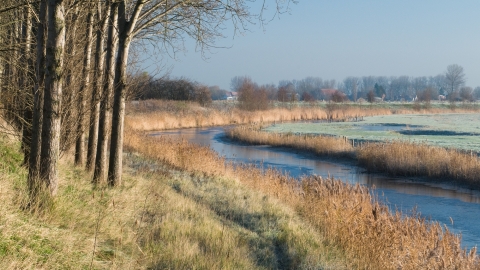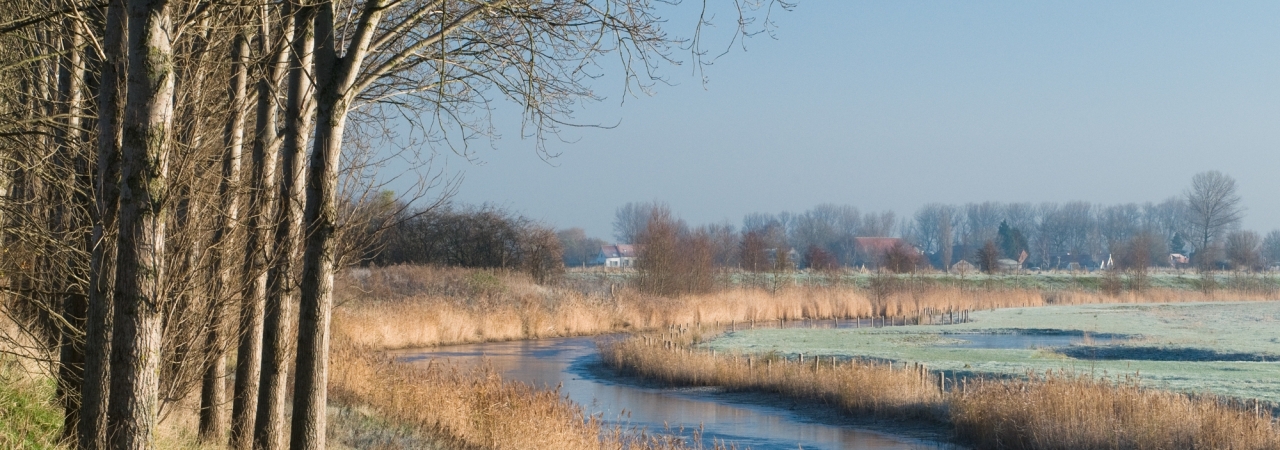After the Eighty Years’ War, the polders between the Line of Oostburg and the southerly located Passageule river were reclaimed. The Line of Oostburg thus lost its strategic function and the Passageule became the new southerly directed defence line. Because of a storm surge in 1404, a tidal channel was created linking the Zwin in the west with the Braakman in the east. During the 15th century, the channel was gradually reclaimed, but following the All Saints Flood (Allerheiligenvloed) of 1570 and the opening of the dykes at the start of the Eighty Years’ War, the channel resumed its old course and the Passageule was created.
From 1672, the Passageule was the main line in West-Zeeuws-Vlaanderen. The famous military engineer Menno van Coehoorn was mainly responsible for expanding the Passageule in around 1700, creating an important link in the water line he had developed between ’t Zwin and Saeftinghe.
The Passageule constantly struggled with silting and was therefore a weak spot in the line. Van Coehoorn and his successors repeatedly tried to resolve this problem through various interventions like damming, shortening, locks, etc. However, not much came of the improvement plans of Van Coehoorn’s successors because the national government was unwilling to invest too much money in maintaining the line. The line was therefore not very effective and was broken three times in the 18th century by French troops.
The first time was on 29 July 1708, during the War of the Spanish Succession. In the vicinity of Turkeye, the French unexpectedly broke through the line. They advanced to the IJzendijke that had been left undefended by the fleeing English mercenaries. The same day, the French withdrew towards Aardenburg, destroying the Waterlandkerkje church and 30 farms on the way.
On 27 April 1747 (during the War of the Austrian Succession), French troops crossed the Passagegeule near the Schaapstelle redoubt. Here the line was most silted. Immediately afterwards, IJzendijke was besieged, surrendering three days later without a shot being fired by the French. The rest of West-Zeeuws-Vlaanderen was subsequently occupied and remained in French hands for a year and a half, until the signing of the Treaty of Aachen.
The last breakthrough took place on 27 July 1794. The brigade of General Vandamme tried to cross the Passagegeule near Turkeye. The inundation (flooding the land) was not complete here and the fort was undermanned (only 200 infantry soldiers, 8 artillery soldiers, four canons and munition for 15 shots). The fort came under heavy fire. At the battery ’t Vrije, where there were no canons, the French broke through and quickly occupied the west of Zeeuws-Vlaanderen.
On the northern bank of the Passageule, there were various defence works. The first fortifications were constructed between 1672 and 1695 and consisted of guardhouses and redoutes (small square fortifications consisting of a guardhouse surrounded by an embankment). Examples are Klein Turkeye and Schaapstelle.
The originally Spanish Drie Gaten and Groot Turkeye redoubts were incorporated in the new line.
In 1702, Van Coehoorn had the Jufferschans under IJzendijke strengthened and had three redoubts constructed in the shallows to the west of Fort Turkeye: Het Vrije, Middelburg, Constantinopel. Near a dam in the Passageule, Fort Nieuwendam was constructed; the Westfort and Oostfort were constructed to guard the Line of the Zuiddiepe (part of the Passageule line under Biervliet).
In around 1775, the marshes along the Passageule were so silted up that they could no longer be flooded. Between Turkeye and the Jufferschans, it was still possible to wade through the line. Despite warnings from various inspectors, no improvements were made. It was only after the threat of war with Austria that the Kapitale Dam (in the extreme east, under Biervliet) and the Bakkersdam (in the extreme west, under Oostburg) were constructed in 1786 and 1789 respectively. With the help of locks in both dams, the water level was controlled and the land along the banks of the Passageule could be flooded. To guard the locks, batteries were erected at the ends of the dams.
In the French Period (1794 – 1814), the line was abolished and subsequently used as a drainage channel.
In order to block the Allied advance in the Battle of the Scheldt, the Germans flooded the Passageule area one last time in September 1944.
The Passageule stream still winds recognisably through the landscape. Most of the line dyke on the northern side still survives. In various places, the sites of former fortifications have been made visible. You can walk along much of the Passageule line over the land along the banks which is now a conservation area. It is also nice to cycle over the line dyke.



